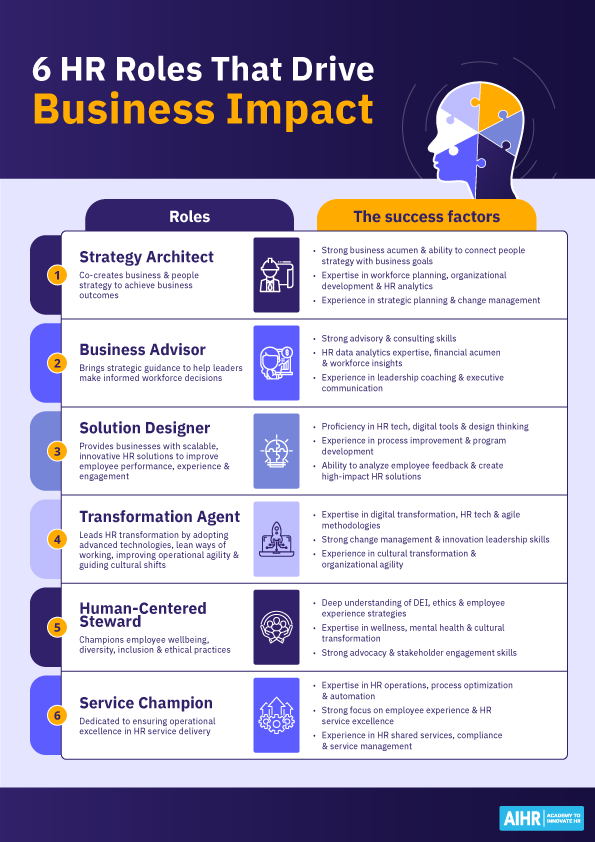HR impact has never been more critical in shaping the future of organizations. A recent study by McKinsey found that 90% of executives believe their HR functions need to reinvent themselves to meet changing business demands.
This reinvention goes beyond merely implementing a new strategy and operating model; it requires thoroughly examining HR’s new stakeholder landscape, their expectations of HR, and how to redefine the HR function for maximum impact.
Six future-ready roles of HR will define the profession’s influence in the coming years. In this article, we outline each role type’s unique contribution and what success looks like and provide insights from our research to guide concrete actions needed to maximize impact.
Shifting challenges and expectations for the HR department
Now and over the next few years, organizations face significant megatrends that threaten business operations if not managed proactively. HR plays a key role in ensuring that businesses can adapt to these challenges.
Economic uncertainty
Inflation, geopolitical tensions, and economic downturns require HR to develop agile workforce strategies that ensure business continuity. HR teams must balance cost efficiency and talent retention while planning for a resilient workforce.
Increased societal responsibility
Organizations are increasingly held accountable for their impact on society. HR is crucial in embedding sustainability, Diversity, Equity, and Inclusion (DEI), ethical labor practices, and corporate social responsibility (CSR) into the organization’s core values.
Digital transformation and AI
The rise of automation, artificial intelligence, and advanced analytics is redefining the nature of work. HR must lead the effort to upskill employees, integrate AI-driven workforce strategies, use AI in HR to streamline work, and ensure a smooth transition to a tech-enabled workplace.
Workforce demographic shifts and changing employee expectations
A multi-generational workforce and evolving employee values require HR to rethink how it attracts, retains, and engages talent. HR policies and practices must balance flexibility with productivity while maintaining engagement and organizational cohesion.
Given these challenges, HR is expected to contribute differently than before. HR has shifted from being an enabler and partner to being core to business decisions on the organization’s future.
In our HR Trends report, we discussed the embedded HR professional, shifting our positioning within the organization to address the needs of an ever-changing stakeholder environment.
Meeting the expectations of a new stakeholder landscape
The modern stakeholder landscape is defined by a wide array of perspectives, interests, and expectations. To drive meaningful impact, HR must balance and respond to the distinct needs of multiple groups:
- Employees: Employees have always been at the heart of HR, but their expectations have changed. They now want more than just fair pay and good working conditions—they look for meaningful work, career growth opportunities, wellbeing support, and an organizational culture that aligns with their values. To meet these needs, HR must prioritize the human element in every policy and practice.
- Leaders: Leadership needs have expanded beyond traditional HR support. Now, HR is expected to actively partner with business leaders to address key business decisions and priorities. To meet these needs, HR must take on a strategic role, driving workforce strategies and guiding organizational change.
- Boards and shareholders: Boards and shareholders increasingly see the workforce as a critical business asset. This gives HR the chance to demonstrate its value by managing talent risks, workforce planning, and leadership succession. By protecting and optimizing key skills and talent, HR can meet the expectations of boards and shareholders.
- Society: Organizations are being held to higher ethical and social standards. HR plays a key role in advancing Diversity, Equity, and Inclusion (DEI), promoting ethical labor practices, and encouraging responsible corporate behavior. This makes society and communities key stakeholders in HR.
As challenges and expectations continue to change, HR needs to move beyond traditional roles and operations. Having the right position within the organization and an effective operating model is essential, but HR also needs the right roles and skills to succeed.
How can HR leaders ensure this happens?
6 types of HR roles for impact
Instead of focusing only on individual roles and skill development, grouping roles into clusters is a more effective way to understand how HR creates value and sustainably builds skills. These clusters, often called role types or personas, group HR roles with similar focus areas, business impact, and success requirements. They clarify HR’s key contributions while outlining the knowledge, skills, and experience needed to achieve those goals.
These role types intentionally overlap and allow for progression, ensuring HR can meet expectations regardless of the specific roles within the team at any given time. For HR leaders, this approach supports collective skill development and deployment, helping HR maintain its impact even as team structures and talent change.
Through our research, we identified six HR role types or personas to reflect the changing nature of HR.
To ensure their relevance, we validated these personas with a panel of HR experts. We also analyzed competency data from over 9,000 HR professionals to understand how HR can meet these evolving demands and determine actions to close any gaps.

1. Strategy Architect
- Focus: Co-creating business and people strategy to achieve business outcomes
- Example roles in this cluster: CHRO, CPO, HR Strategy Head, HR Executive Team
The Strategy Architect ensures HR is not just a contributor but a key driver of business strategy. As part of the leadership team, this role helps shape the business strategy while owning and aligning the people strategy with company goals. By focusing on talent management, organizational culture, and workforce planning, the Strategy Architect ensures HR efforts directly support long-term business success.
Using workforce analytics, tracking market trends, and applying organizational design principles, the Strategy Architect helps leadership anticipate future talent needs and create HR strategies that give the business a competitive edge.
Factors for success
Strong business acumen and ability to connect people strategy with business outcomes
Expertise in workforce planning, organizational development, and HR analytics
Experience in strategic planning and change management
Maximizing impact: Key strategies for HR leaders
- Develop business acumen early: Our research shows that business acumen develops over time, with the biggest gains after ten years of experience. Focus on developing financial literacy and market awareness early in your HR team.
- Create opportunities for exposure to strategy development: Professionals who actively shape strategy are more confident in demonstrating HR’s impact. Provide exposure and structured development to transition HR professionals into strategy-focused roles.
- Actively develop change leadership: Many (43%) HR professionals struggle with driving transformation initiatives. Strengthen change leadership through active development and exposure to change management frameworks, stakeholder engagement, and resilience-building strategies.
2. Business Advisor
- Focus: Provides strategic guidance to help leaders make informed decisions about their workforce.
- Example roles in this cluster: HRBPs, HR Directors, Organizational Development teams.
The Business Advisor is a trusted consultant to business leaders, providing data-driven insights and strategic advice on key people decisions. They support areas like leadership development, workforce planning, and cultural transformation, ensuring HR is part of the decision-making process and drives business growth.
Business Advisors help leaders understand workforce trends, address talent risks, and align people strategies with changing business needs.
Factors for success
Strong advisory and consulting skills
Expertise in HR data analytics, financial acumen, and workforce insights
Experience in leadership coaching and executive communication
Maximizing impact: Key strategies for HR leaders
- Build an understanding of client needs: HR professionals who understand employee and business needs are more effective advisors. Leverage client-centric approaches like employee experience design to help your team understand client needs.
- Use analytics to drive business conversations: The ability to ask the right questions and frame business problems effectively is critical. To do this well, build HR analytics and data storytelling skills to turn workforce insights into action.
- Develop interpersonal skills to execute effectively: Interpersonal skills are established over time, making them a core skill to build throughout an HR career. Support Business Strategists to develop problem-solving, stakeholder management, and communication skills as foundational skills to drive business influence.
3. Solution Designer
- Focus: Provide businesses with scalable, innovative HR solutions that improve employee performance, experience and engagement
- Example roles in this cluster: CoE Teams, HR Technology Teams
The Solution Designer develops scalable and innovative HR solutions to improve employee performance, experience, and engagement. This role uses a design-thinking approach to ensure HR policies, programs, and processes are practical, effective, and aligned with business goals. Whether it’s developing learning programs, career frameworks, or engagement tools, the Solution Designer ensures these solutions are agile, tech-enabled, and focused on the employee experience.
Factors for success
Proficiency in HR technology, digital tools, and design thinking
Experience in process improvement and program development
Ability to analyze employee feedback and create high-impact HR solutions
Maximizing impact: Key strategies for HR leaders
- Leverage data proactively to design solutions: HR professionals generally struggle to establish new and proactive data sources that underpin HR practices. Develop data creation and decision-making skills by defining key HR metrics, using analytics tools, and aligning data with business goals.
- Use data insights to get buy-in: HR practitioners who understand and use data effectively are also better at communicating insights to stakeholders and influencing decisions. Focus on developing data visualization and communication skills to help Solution Designers present HR insights compellingly and gain buy-in to solutions.
- Collaborate for impact: Better collaboration skills lead to more confident problem-solving skills and enhance solutions. Help your HR team create opportunities for cross-functional projects and design thinking to develop innovative, business-aligned HR solutions.
4. Transformation Agent
- Focus: Leads the charge in transforming HR by adopting advanced technologies, fostering lean ways of working, improving operational agility, and leading cultural shifts.
- Example roles in this cluster: HR Technology, Change Management, Organizational Development teams.
The Transformation Agent is key in modernizing HR by spearheading digital transformation, enhancing operational agility, and promoting cultural shifts. This role type ensures that HR adopts advanced technologies, implements efficient workflows, and nurtures a culture of innovation and continuous improvement. The Transformation Agent advocates for HR modernization, assisting organizations in navigating change and staying ahead of disruption.
Factors for success
Expertise in digital transformation, HR technology, and agile methodologies
Strong change management and innovation leadership skills
Experience in cultural transformation and organizational agility
Maximizing impact: Key strategies for HR leaders
- Translate data into insights: HR professionals (58%) struggle to translate data insights into business-driven HR solutions. Support your team in developing data visualization and storytelling skills so that they can translate HR insights into impactful, business-driven solutions.
- Sustain digital agility: Digital agility tends to plateau mid-career, which puts HR professionals at risk of falling behind in technology-driven solutions. Strengthen digital readiness by actively implementing HR technology in daily workflows and encourage hands-on use of automation, people analytics, and AI-driven solutions.
- Drive continuous adoption: HR professionals who use technology are more likely to encourage and promote organization-wide adoption of new tools. Commit to continuous upskilling and use of HR technology to promote broader digital adoption.
5. Human-Centered Steward
- Focus: Champions employee wellbeing, diversity, inclusion, and ethical practices
- Example roles in this cluster: DEIB, CSR, ESG
The Human-Centered Steward is dedicated to promoting employee wellbeing, diversity, inclusion, and ethical workplace practices. This persona ensures that organizations prioritize employees, cultivate inclusive cultures, and create environments where individuals feel valued, respected, and supported.
Whether driving Diversity, Equity, and Inclusion (DEI) initiatives, enhancing employee wellness programs, or advocating for ethical human resources practices, the Human-Centered Steward is committed to upholding people-first policies within the organization.
Factors for success
Deep understanding of DEI, ethics, and employee experience strategies
Expertise in wellness, mental health, and cultural transformation
Strong advocacy and stakeholder engagement skills
Maximizing impact: Key strategies for HR leaders
- Balance wellbeing and productivity efforts: HR professionals are confident in building resilience but many struggle to balance wellbeing and productivity efforts (40%). Develop skills in employee wellbeing strategies, psychological safety, and human-centered leadership to create a culture where performance and wellbeing coexist rather than compete.
- Move from advocating values to driving inclusive action: HR professionals excel at championing organizational values and social responsibility but feel less confident in creating inclusive workplaces and managing stakeholders (42%). Strengthen HR’s ability to translate advocacy into tangible impact by enhancing strategic influence, stakeholder alignment, and execution in DEIB and sustainability initiatives.
- Make risk management skills a priority: Our data shows that risk mitigation skills only develop later in HR careers. Embed training on employment law and HR compliance into early-career development programs to reinforce these skills early on.
6. Service Champion
- Focus: Dedicated to ensuring operational excellence in HR service delivery
- Example roles in this cluster: Service Centres, Benefits Teams, Policy Champions, Generalists
The Service Champion is dedicated to achieving operational excellence in HR service delivery, ensuring that HR processes are smooth and efficient, and enhancing the overall employee experience.
This role type emphasizes process optimization, HR automation, and seamless service delivery, ensuring that HR operations are responsive, reliable, and aligned with business needs. Using technology and continuous improvement methodologies, the Service Champion ensures that HR is a dependable function that supports employees and improves the business’s efficiency.
Factors for success
Expertise in HR operations, process optimization, and automation
Strong focus on employee experience and HR service excellence
Experience in HR shared services, compliance, and service management
Maximizing impact: Key strategies for HR leaders
- Invest in building data literacy skills: Without dedicated focus and continuous upskilling, data literacy stagnates, which impacts the ability to use HR analytics to measure service efficiency and optimize processes. Use HR dashboards and reporting tools to track process performance and identify areas for optimization.
- Build confidence in using digital tools: HR professionals in service-oriented roles report the lowest confidence in using digital tools effectively. Only 25% of HR professionals in service-driven roles feel highly confident in leveraging digital tools effectively, compared to 35% in strategy-focused roles. Ensure continuous HR technology upskilling, automation adoption, and process improvement methodologies to ensure scalable, tech-enabled HR operations.
- Make interpersonal skills the heart of service delivery: HR professionals who work effectively with others better navigate service-related challenges, making interpersonal skills a critical enabler of HR service excellence. Provide stakeholder management and interpersonal communication training to elevate interpersonal skills.
Taking action
These six HR role personas outline the key skills needed to make an impact in today’s business environment. HR leaders need to take clear steps to assess and develop these personas to prepare HR teams for the future.
Start by grouping HR team roles into these six personas to understand how roles are distributed. Depending on your structure and operating model, this may vary, but our career map is a helpful starting point for mapping roles.
Next, evaluate how well the team’s skills align with the personas to identify strengths and areas for improvement. A skills audit or self-assessment can help pinpoint where individuals and the overall HR function feel confident—and where there are gaps.
Finally, focus on upskilling and learning opportunities. Upskilling initiatives should strengthen technical and strategic HR capabilities while leveraging mentorship, cross-functional projects, and leadership exposure can help build expertise.
The role of HR is not just about executing processes. It’s about driving transformation, shaping strategy, and enhancing employee experiences. By deploying these six personas and actively developing the skills needed to sustain them, HR leaders can help their teams elevate their impact and create lasting value for the organizations.
How we can help
AIHR’s enterprise solutions help HR leaders build the right skills and capabilities within their teams that drive real business impact.
By combining data-driven insights with modern best practices, we provide HR teams with a roadmap to build the right knowledge and skills to achieve business goals. This ensures HR doesn’t just support organizational objectives but actively helps achieve them.
With AIHR’s Certificate Programs, HR leaders can develop future-ready teams of T-Shaped HR professionals—experts with deep knowledge and versatile, cross-functional skills. These professionals are equipped to adapt to market changes, tackle complex challenges, and deliver lasting value to their organizations.








